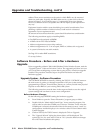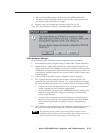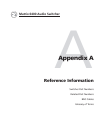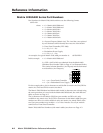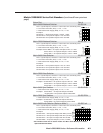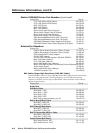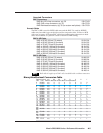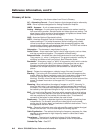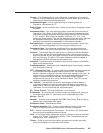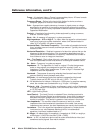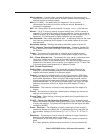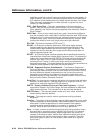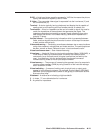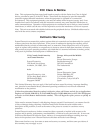
Reference Information, cont’d
Matrix 3200/6400 Series • Reference InformationA-6
Glossary of terms
Following is a list of terms taken from Extron’s Glossary.
AC – Alternating Current – Flow of electrons that changes direction alternately.
ADA – Extron’s product designation for Analog Distribution Amplifier.
AMPS – Amperes – A unit of measurement for current.
Analog – Analogue – A continuous signal that takes time to make a transition
from one level to another. Standard audio and video signals are analog. This
signal has an infinite number of levels between its highest and lowest value.
(Not represented by bits, such as with digital.)
ANSI – American National Standards Institute
ASCII – American Standard Code for Information Interchange – The standard
code consisting of 7-bit coded characters (8 bits including parity check),
utilized to exchange information between data processing systems, data
communication systems, and associated equipment. The ASCII set contains
control characters and graphic characters.
Attenuation – The decrease in magnitude of a signal.
Audio Follow – A term used when audio is tied to other signals, such as video,
and they are switched together. (The opposite of Break-away)
Balanced Audio – A method that uses three conductors for one audio signal.
They are plus (+), minus (-) and ground. The ground conductor is strictly for
shielding, and does not carry any signal. Also Differential Audio.
Bandwidth – A frequency range, or “band” of frequencies, within which a device
operates. In audio and video, it is the band of frequencies that can pass
through a device without significant loss or distortion. The higher the
bandwidth, the sharper the picture; low bandwidth can cause a “fuzzy”
picture.
Barrel – Outward curved edges on a display image. Also see “pincushion”.
Blanking – The turning off of the electron beam that scans the image onto the
screen. When the beam completes a scan line it must return (retrace) back
to the left. During this time, the beam must be turned off (horizontal
blanking). Similarly, when the last line has been scanned at the bottom of the
screen, the beam must return to the upper left. This requires vertical
blanking.
Blooming – Most noticeable at the edges of images on a CRT, “blooming” is
when the light (color) is so intense that it seems to exceed the boundary of
the object. Thin lines and sharp edges could look thick and fuzzy. This may
be caused by the brightness being set to high, or by a high voltage problem.
BNC – It is a cylindrical Bayonet Connector which operates with a twist-locking
motion. Two curved grooves in the collar of the male connector are aligned
with two projections on the outside of the female collar. This allows the
connector to be locked in place without the need of tools.
Break-away – The ability to separate signals for the purpose of switching them
independently. For example: an audio and video signal from the same
source may be “broken away” and switched to different destinations. This is
the opposite of the term “follow”.
Buffer – Generally referred to as a unity gain amplifier used to isolate the signal
source from the load. This is for both digital and analog signals.
Cable Equalization – The method of altering the frequency response of a video
amplifier to compensate for high frequency losses in cables that it feeds.
(See Peaking.)
Capacitance – The storing of an electrical charge. At high frequencies,
capacitance that exists in cables also represents a form of impedance.
Cathode Ray Tube – See CRT.



